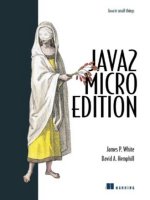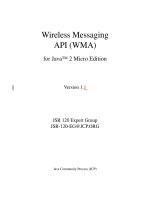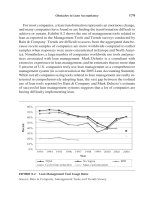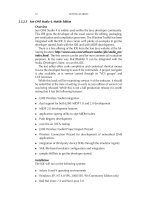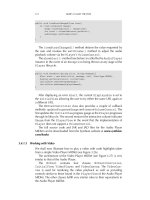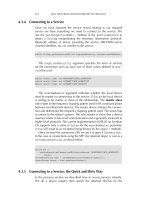Programming java 2 micro edition for symbian os phần 7 docx
Bạn đang xem bản rút gọn của tài liệu. Xem và tải ngay bản đầy đủ của tài liệu tại đây (481.87 KB, 50 trang )
272 MIDP 2.0 CASE STUDIES
expenses that have been approved or rejected by the current user acting
in the budget holder role.
The synchronization thread communicates with the server using the
HTTP protocol. XML formatted requests that contain all the information
that the device wishes to exchange are sent. After processing the request,
the server formats an XML response containing updates.
XML is space inefficient; many additional bytes are required to encode
information. So why use XML in an environment where memory is at a
premium and the network connections are slow? XML is convenient, it
is easy to validate and there are many existing tools and APIs to simplify
its use, allowing the expense application prototype to be created in the
minimum of time.
The javax.microedition.io.HttpConnection class is used
for the server communication. Requests to the server use a utility method,
sendMessageToServer(), that has a single parameter containing the
XML request to be sent. An HttpConnection is opened to the server
URL and the XML request sent via the connection’s OutputStream.
The response is read into a StringBuffer before being returned
to the caller. If there is an error then an exception is thrown that will
eventually find its way back to the synchronization form to be presented
to the user.
// SynchronizationThread sendMessageToServer() method
private String sendMessageToServer(String message)
throws IOException, ServerCommException {
StringBuffer sb = new StringBuffer();
HttpConnection connection = null;
InputStream is = null;
// open connection
connection = (HttpConnection)Connector.open(settings.getSyncServer());
// send message to server
OutputStream os = connection.openOutputStream();
os.write(message.getBytes());
os.close();
// make sure we got a good response code, i.e. >= 200 && < 300
if ((connection.getResponseCode() >= 200)
&& (connection.getResponseCode() < 300)) {
is = connection.openInputStream();
byte[] buffer = new byte[512];
int bytesRead = 0;
while (-1 != (bytesRead = is.read(buffer, 0, 512))) {
sb.append(new String(buffer, 0, bytesRead));
}
} else {
// error of some kind
throw new ServerCommException(
"Server communications error: "
+ connection.getResponseCode()
+","
+ connection.getResponseMessage());
}
// close connection.
THE EXPENSE APPLICATION 273
connection.close();
return sb.toString();
}
5.2.6.3 Format of Synchronization Message
An XML schema was created for the interaction between the client device
and the server. This allowed the XML to be validated as well as allowing
the server side parsing code to be generated using JAXB, the Java API for
XML Binding. The schema is shown below.
<xsd:schema xmlns:xsd="www.w3.org/2001/XMLSchema">
<xsd:element name="etsync" type="ExpenseTrackerSync"/>
<xsd:complexType name="ExpenseTrackerSync">
<xsd:sequence>
<xsd:element name="req" type="ExpenseTrackerRequest"
minOccurs="0" />
<xsd:element name="resp" type="ExpenseTrackerResponse"
minOccurs="0" />
</xsd:sequence>
</xsd:complexType>
<xsd:complexType name="ExpenseTrackerRequest">
<xsd:sequence>
<xsd:element name="userupdate" type="UpdateUser" minOccurs="0"
maxOccurs="1" />
<xsd:element name="expense" type="PhoneExpense" minOccurs="0"
maxOccurs="unbounded" />
</xsd:sequence>
<xsd:attribute name="lastSyncId" type="xsd:integer" />
<xsd:attribute name="userId" type="xsd:integer" />
</xsd:complexType>
<xsd:complexType name="ExpenseTrackerResponse">
<xsd:sequence>
<xsd:element name="mainuser" type="User" minOccurs="0"
maxOccurs="1" />
<xsd:element name="subord" type="User" minOccurs="0"
maxOccurs="unbounded"/>
<xsd:element name="expense" type="PhoneExpense" minOccurs="0"
maxOccurs="unbounded"/>
</xsd:sequence>
<xsd:attribute name="sid" type="xsd:integer" />
</xsd:complexType>
<xsd:complexType name="UpdateUser">
<xsd:attribute name="name" type="xsd:string" use="required"/>
</xsd:complexType>
<xsd:complexType name="PhoneExpense">
<xsd:sequence>
<xsd:element name="owner" type="xsd:integer" minOccurs="1"
maxOccurs="1" />
<xsd:element name="state" type="xsd:integer" minOccurs="1"
maxOccurs="1" />
<xsd:element name="type" type="xsd:integer" minOccurs="1"
maxOccurs="1" />
<xsd:element name="receiptdate" type="xsd:date" minOccurs="1"
maxOccurs="1" />
<xsd:element name="amount" type="xsd:integer" minOccurs="1"
274 MIDP 2.0 CASE STUDIES
maxOccurs="1" />
<xsd:element name="currency" type="xsd:string" minOccurs="1"
maxOccurs="1" />
<xsd:element name="vatpercentage" type="xsd:integer"
minOccurs="1" maxOccurs="1"/>
<xsd:element name="project" type="xsd:integer" minOccurs="1"
maxOccurs="1" />
<xsd:element name="dept" type="xsd:integer" minOccurs="1"
maxOccurs="1" />
<xsd:element name="createdate" type="xsd:dateTime"
minOccurs="1" maxOccurs="1" />
<xsd:element name="lastsyncid" type="xsd:integer"
minOccurs="1" maxOccurs="1"/>
<xsd:element name="ownernotes" type="xsd:string" minOccurs="1"
maxOccurs="1" />
<xsd:element name="bhnotes" type="xsd:string" minOccurs="1"
maxOccurs="1" />
</xsd:sequence>
</xsd:complexType>
<xsd:complexType name="User">
<xsd:attribute name="id" type="xsd:int" use="required"/>
<xsd:attribute name="name" type="xsd:string" use="required"/>
</xsd:complexType>
</xsd:schema>
On the device, XML requests are encoded by appending to a string
buffer. There is no need to use an XML library: it overcomplicates the
process and increases memory overhead. The kXML library was used to
parse the XML responses on the device. It is designed to run under MIDP
and has a small memory footprint. The library can be downloaded from
.
5.2.6.4 Parsing XML using kXML
The kXML parser is simple to use, once an InputStream has been set.
Parsing involves iterating through events in the XML stream. An event
includes beginning and end tags, elements and attributes. While parsing,
getName gets the tag name and getAttributeValue gets a named
attribute from the current tag. For tags that have text between a start and
end tag, the getNext() method must be used – the text is considered
another event.
The code below shows the kXML parser in action. In this example
all information is made up of attributes within tags, so the parser’s
getNext() method is not used for retrieving text (see processEx-
penseResponse in the midlet.sync.SynchronizeThread class
for an example of its usage).
// SynchronizationThread processPersonResponse() method
private void processPersonResponse(String reply)
throws IOException, XmlPullParserException, DAOException {
KXmlParser parser = new KXmlParser();
THE EXPENSE APPLICATION 275
// turn the reply into a input stream for the xml parser
ByteArrayInputStream bais = new ByteArrayInputStream(reply.getBytes());
parser.setInput(bais, null);
int eventType = parser.getEventType();
while (eventType != KXmlParser.END_DOCUMENT)
{
if (eventType == KXmlParser.START_TAG) {
// the information we want is always in the attributes, parsing
// is simple: if it’s a tag we are interested in then get
// the information, otherwise ignore!
int tagId = 0; // id == 1 for main user, 2 == subordinate
if (parser.getName().equals(TAG_PERSON_MAIN))
{
// main user, ensure they are the first person
tagId = 1;
} else if (parser.getName().equals(TAG_PERSON_SUBORD)) {
// subordinate person, ensure they are in the RMS
tagId = 2;
} else if (parser.getName().equals(TAG_RESPONSE)) {
syncId = Long.parseLong(parser.getAttributeValue("",
TAG_RESPONSE_SYNCID));
}
// are we doing some processing??
if (tagId != 0)
{
// get the attributes and do some more work
String name = parser.getAttributeValue("", TAG_PERSON_NAME);
short id = Short.parseShort(parser.getAttributeValue("",
TAG_PERSON_ID));
short bhId = -1;
if (tagId == 1)
{
// remove current users
} else {
// sub ord instead of main user.
bhId = settings.getUserId();
}
// ensure the RMS is update to date
}
}
eventType = parser.next();
}
bais.close();
}
5.2.6.5 Message Exchange Example
An example of the XML request and response messages from a synchro-
nization operation now follows.
The first request and response is for a user that is using a device for
the first time. The request includes the name the user entered into the
application settings and the response includes the user’s unique ID and
any claimants, of which there are none in this instance.
276 MIDP 2.0 CASE STUDIES
<etsync>
<req lastSyncId="0" userId="0">
<userupdate name="Yossarian" />
</req>
</etsync>
<?xml version="1.0" encoding="UTF-8" standalone="yes"?>
<etsync>
<resp sid="424">
<mainuser name="Yossarian" id="2">
</mainuser>
</resp>
</etsync>
The next exchange retrieves the expenses that already exist for the
user. Note how the last sync ID remains 0 for the request to ensure that
all expenses are exchanged:
<etsync>
<req lastSyncId="0" userId="2">
</req></etsync>
<?xml version="1.0" encoding="UTF-8" standalone="yes"?>
<etsync>
<resp sid="425">
<expense>
<owner>2</owner>
<state>4</state>
<type>0</type>
<receiptdate>2003-06-09+00:00</receiptdate>
<amount>1299</amount>
<currency>£ </currency>
<vatpercentage>1750</vatpercentage>
<project>3</project>
<dept>2</dept>
<createdate>2003-06-11T19:52:46.000+00:00</createdate>
<lastsyncid>367</lastsyncid>
<ownernotes>one</ownernotes>
<bhnotes></bhnotes>
</expense>
<expense>
<owner>2</owner>
<state>2</state>
<type>2</type>
<receiptdate>2003-06-16+00:00</receiptdate>
<amount>2197</amount>
<currency>$ </currency>
<vatpercentage>1750</vatpercentage>
<project>0</project>
<dept>0</dept>
<createdate>2003-06-16T08:55:21.000+00:00</createdate>
<lastsyncid>381</lastsyncid>
<ownernotes></ownernotes>
<bhnotes></bhnotes>
</expense>
</resp>
</etsync>
THE EXPENSE APPLICATION 277
The final XML request shows a new expense claim being submitted to
the server:
<etsync>
<req lastSyncId="436" userId="2">
<expense>
<owner>2</owner>
<state>2</state>
<type>0</type>
<receiptdate>2003-12-09</receiptdate>
<amount>1299</amount>
<currency>£</currency>
<vatpercentage>1750</vatpercentage>
<project>0</project>
<dept>0</dept>
<createdate>2003-12-09T11:22:20</createdate>
<lastsyncid>437</lastsyncid>
<ownernotes>hello world</ownernotes>
<bhnotes></bhnotes>
</expense>
</req>
</etsync>
A discussion of how the requests are processed on the server takes
place in the next section.
5.2.7 Implementation of the Web Server Components
Apache Tomcat is used to provide the server functionality for the expense
application. Java Server Pages (JSP) are used in conjunction with Jav-
aBeans to provide a view of existing expenses. A servlet is used for
the synchronization process. This section gives an overview of the web
application.
Figures 5.9 and 5.10 are examples of the main web pages for the
expense application. The first image shows all the expenses in the system
for a single user, the second shows the full details of an expense item.
The web application uses a relational database management system
(RDBMS) to store the expenses and user information. The schema for
the database has just three tables. A homegrown library is used to
simplify the database code, allowing a simple mapping of a database
table to a Java class. See the source code on the support website at
www.symbian.com/books
for more information.
The most complex part of the server is the synchronization servlet. All
XML parsing uses the Java API for XML Binding (JAXB). JAXB was used to
create a class hierarchy from the XML schema: if the schema changes the
classes can be automatically regenerated as part of the build process to
ensure that they always correctly map to the XML stream.
When the servlet receives a synchronization request, JAXB is used to
unmarshal the information into an object hierarchy that is used to process
278 MIDP 2.0 CASE STUDIES
Figure 5.9 Expenses list for a user.
Figure 5.10 Expense item details.
the request. A response is built by creating an object hierarchy from
classes generated by JAXB. Once processing is complete, the response
hierarchy is marshaled into an XML stream and sent back to the device.
The synchronization servlet does not handle any XML directly.
JAXB is available from Sun as part of the Java Web Services Toolkit.
THE EXPENSE APPLICATION 279
5.2.8 Building the MIDlet
This next section details the build and run scripts that were used during
the development. The scripts are modified versions of batch files that are
included with Sun’s Wireless Toolkit.
5.2.8.1 Build Script
The build script performs the following operations:
1. It builds the Java source into class files.
2. It packages the classes into a Java archive (JAR).
3. It reduces the application size using obfuscation.
4. It pre-verifies the application ready for deployment.
5. It updates the Java application descriptor (JAD) file with the correct
application JAR file size.
Building the Class Files
Sun’s Java Development Kit (JDK) is used to build the class files from the
Java source files. The javac command line is fairly standard apart from
an additional parameter to specify that the J2ME libraries should be used
to provide the bootstrap classes:
javac -bootclasspath %WTK_HOME%\lib/midpapi.zip -d build\classes
-classpath build\classes src/java/org/xmlpull/v1/*.java
src/java/org/kxml2/io/*.java src/java/midlet/utils/*.java
src/java/midlet/model/*.java src/java/midlet/view/*.java
src/java/midlet/uitools/*.java src/java/midlet/sync/*.java
Packaging into a Java Archive
An application JAR file is created from the classes. The obfuscation
process requires separate input and output JAR files. For this reason an
intermediate filename of ExpenseTrackerTemp.jar is used for the
initial packaging operation.
jar cmf src\meta\MANIFEST.MF build\ExpenseTrackerTemp.jar
-C build\classes .
Obfuscating
Obfuscation must be performed prior to pre-verification. If pre-verification
is performed first, the obfuscation process invalidates the pre-verification
checksums and the MIDlet will not run.
Sun’s Wireless Toolkit ships with the Proguard obfuscation library (see
). To use Proguard, a configuration file
280 MIDP 2.0 CASE STUDIES
must be created that contains the options for the obfuscation process.
The file is passed to Proguard as a command line parameter, as follows.
If obfuscation is not required, the command should be commented out of
the build script.
java -jar lib\proguard.jar @proguard.txt
The contents of the configuration file, proguard.txt, follow:
-libraryjars /wtk20/lib/midpapi.zip
-injars build/ExpenseTrackerTemp.jar
-outjar build/ExpenseTracker.jar
-keep public class * extends javax.microedition.midlet.MIDlet
Pre-verifying the Application
The standard Java runtime performs verification of classes prior to launch-
ing a Java application, to ensure that class files are well-formed and do
not contain any malicious code. MIDP specifies that a MIDlet should
be pre-verified prior to deployment, allowing the MIDP implementation
on the wireless device to be reduced in size. Sun’s Wireless Toolkit is
supplied with a tool to perform pre-verification; the following command
line shows this operation in the build script:
%WTK_HOME%\bin\preverify -classpath
%WTK_HOME%\lib\midpapi.zip;build\tmpclasses build\ExpenseTracker.jar
Updating the JAD File
The final step in creating a deployable MIDlet is to update the JAD file
with the size of the application JAR. The JAD file contains configuration
information that a device requires for installing, managing and running a
MIDlet, such as the MIDlet’s main class and vendor information. A small
Java program was created to embed the size into a template file and write
out the expense application’s JAD. The command in the build script is
as follows:
java -cp . SizeEncoder build\ExpenseTracker.jar
The JAD template file is as follows (the $size$ token is replaced with
the size of the JAR file when the template is used):
MIDlet-1: Expenses,,midlet.view.ExpenseMidlet
MIDlet-Jar-Size: $size$
MIDlet-Jar-URL: ExpenseTracker.jar
MIDlet-Name: Expenses
THE EXPENSE APPLICATION 281
MIDlet-Vendor: Symbian IS
MIDlet-Version: 1.0
MicroEdition-Configuration: CLDC-1.0
MicroEdition-Profile: MIDP-2.0
5.2.8.2 Run Script
The run script has only one line of real interest: the line that launches the
expense MIDlet in Sun’s emulator. There are a number of useful parame-
ters available when using the emulator; for example, –Xheapsize sets
the maximum heap size and allows a MIDlet to be tested in different
memory conditions. The emulator skin can be set using the –Xdevice
parameter; the skin name should mirror the directory name of the skin in
the Wireless Toolkit’s wtklib directory. In the following example, the
Sony Ericsson P900 skin would be used. Default values are used for any
parameters not set on the command line but they can be changed using
the Preferences application in the toolkit.
%WTK_HOME%\bin\emulator -classpath build\ExpenseTracker.jar -
Xdescriptor:build\ExpenseTracker.jad -Xheapsize:192k -
Xdevice:SonyEricsson_P900
Sun’s emulator makes output from the System.out and System.err
streams visible on the console when running a MIDlet, providing a good
source of debugging information. On the device this output is not gener-
ally available. Fortunately, the behavior of the device is usually consistent
with the emulator. Several bugs found on a device when developing the
expense application were reproducible using the emulator.
To run an application on a wireless device, the MIDlet must first be
installed. The documentation for each device must be consulted for the
correct installation instructions.
5.2.9 Summary
We have demonstrated how an expense claim application can be written
and have shown some of the techniques that are essential to the success
of MIDlets.
As the number of devices that ship with MIDP 2.0 increases, it will
become a compelling platform. The inclusion of key features such as
custom items and enhanced networking now means that MIDP is ready
for the creation of enterprise applications in addition to the games that
are currently common.
Full source code for this application can be downloaded from
www.
symbian.com/books
.
282 MIDP 2.0 CASE STUDIES
5.3 The Demo Racer Game
In this case study we will look at a sample application using the Game
API. The Demo Racer MIDlet demonstrates how the Game API can be
used to build rich gaming content (see Figure 5.11).
This sample application illustrates the use of LayerManager to man-
age a complex composite scene of layers (a TiledLayer background and
Sprites) and also demonstrates the use of collision detection between
the sprites (the car with the puddle and the car with the start–finish line).
A UML class diagram of the application is shown in Figure 5.12.
We will discuss the application class by class, starting with the layers
that make up the scene.
Figure 5.11 The Demo Racer MIDlet running on a Nokia 6600.
5.3.1 The Background Class
package demoracer;
import javax.microedition.lcdui.game.*;
import javax.microedition.lcdui.*;
public class Background extends TiledLayer {
static final int WIDTH = 5;
static final int HEIGHT = 5;
static final int TILE_WIDTH = 60;
THE DEMO RACER GAME 283
static final int TILE_HEIGHT = 47;
static int xMove = -2;
static int yMove = 0;
public Background(int columns, int rows, Image image, int tileWidth,
int tileHeight)
{
super(columns, rows, image, tileWidth, tileHeight);
// the array which is the tile map for the tiledlayer
int[] map =
{
4,4,4,4,4,
5,5,5,5,5,
3,3,3,3,3,
1,2,1,2,1,
3,3,3,3,3
};
// insert the tiles into the tiled layer using the setCell() method
for (int i = 0; i < map.length; i++)
{
int column = i % WIDTH;
int row = (i - column) / WIDTH;
setCell(column, row, map[i]);
}
}
public void tick(){
move(xMove,yMove);
if (this.getX() == (this.getCellWidth() * -2)) {
setPosition(0, 0);
}
}
}
javax.microedition.lcdui.game.GameCanvas javax.microedition.lcdui.game.Layer
javax.microedition.lcdui.game.TiledLayer javax.microedition.lcdui.game.SpriteRacerMidlet
StartFinishBackground
RacerLayerManager
CarPuddle
RacerCanvas
Figure 5.12 UML class diagram of the Demo Racer MIDlet.
284 MIDP 2.0 CASE STUDIES
Figure 5.13 The image used to build up the background layer.
Figure 5.14 The background layer.
The constructor takes the image shown in Figure 5.13, consisting of
five tiles, each of 60 × 47 pixels.
This is then used to construct the background layer (Figure 5.14),
which consists of a grid of 5 × 5 cells.
For each application redraw cycle, the tick() method is called to
move the position of the TiledLayer two pixels to the left (i.e. −2)
relative to the co-ordinate system of the object upon which it is ultimately
rendered (in this case the GameCanvas). When the TiledLayer has
been offset by an amount equal to the width of two cells of the background
grid (120 pixels requiring 60 redraw cycles – enough for the pattern to
repeat itself), the position of the TiledLayer is re-set to the origin of the
co-ordinate system of the rendering object.
5.3.2 The Puddle Class
A Puddle is an instance of Sprite to facilitate easy collision detection.
The Puddle Sprite is created from an image consisting of just one
frame (Figure 5.15).
Figure 5.15 The image used to build up the puddle Sprite.
THE DEMO RACER GAME 285
package demoracer;
import javax.microedition.lcdui.Image;
import javax.microedition.lcdui.game.Sprite;
public class Puddle extends Sprite
{
static final int FRAME_COLS = 1;
static final int FRAME_WIDTH = 1;
private int xInitial;
private int yInitial;
private int repPeriod
public Puddle(Image image, int width, int height, int x, int y)
{
super(image, width, height);
setPosition(x, y);
xInitial = x;
yInitial = y;
repPeriod = 2*Background.TILE_WIDTH;
}
public void tick() {
if (repPeriod == 0) {
setPosition(xInitial, yInitial);
repPeriod = 2*Background.TILE_WIDTH;
} else{
move(Background.xMove, Background.yMove);
}
// set visible to false if it is off screen
if(getX() + getWidth() <= 0)
{//definitely outside Canvas clip area
setVisible(false);
} else {
if( !isVisible() ) {
setVisible(true);
}
}
repPeriod ;
}
}
The tick() method, called by the application clock, moves the
puddle Sprite in step with the background layer, so that the puddles
appear to remain stationary on the race track. The cycle length of 120
(repPeriod = 2*Background.CELL_WIDTH) is half that required to
complete a lap, so the puddle appears twice per lap. At the end of
the cycle the puddle is repositioned with setPosition(xInitial,
yInitial) (remember setPosition positions the Sprite in the
co-ordinate system of the painting object, here a GameCanvas). When
the puddle Sprite is definitely outside the clip area displayed by the
Canvas, its visibility is set to false.
286 MIDP 2.0 CASE STUDIES
Figure 5.16 The image used to build the Sprite for the start–finish line.
5.3.3 The StartFinish Class
This is similar to Puddle, again extending Sprite to facilitate ease of
collision detection. Once more, the Sprite is created from an image
consisting of a single frame (Figure 5.16).
package demoracer;
import javax.microedition.lcdui.Image;
import javax.microedition.lcdui.game.Sprite;
public class StartFinish extends Sprite
{
static final int FRAME_COLS = 1;
static final int FRAME_WIDTH = 1;
private int xInitial;
private int yInitial;
private int repPeriod;
private boolean lapComplete = false;
public StartFinish(Image image, int width, int height, int x, int y)
{
super(image,width,height);
this.setPosition(x,y);
xInitial = x;
yInitial = y;
repPeriod = 4*Background.TILE_WIDTH;
}
public boolean getLapComplete(){return lapComplete;}
public void setLapComplete(boolean bln){lapComplete = bln;}
public void tick() {
if (repPeriod == 0) {
setPosition(xInitial, yInitial);
repPeriod = 4*Background.TILE_WIDTH;
} else{
move(Background.xMove, Background.yMove);
}
// set to invisible if the sprite is off screen.
if(getX() + getWidth() <= 0)
{//definitely outside Canvas clip area
setVisible(false);
} else {
if( !isVisible() ) {
setVisible(true);
}
}
repPeriod ;
}
}
THE DEMO RACER GAME 287
A tick() method is called by the application clock to keep the position
of the start finish line in step with the background layer (and thus appear to
remain stationary on the race track). The cycle length of 240 (repPeriod
= 4*Background.CELL_WIDTH) defines the length of a lap.
5.3.4 The Car class
package demoracer;
import javax.microedition.lcdui.Image;
import javax.microedition.lcdui.game.Sprite;
public class Car extends Sprite {
static final int RAW_FRAMES = 4;
static final int DRIVE_NORMAL = 0;
static final int DRIVE_WET = 1;
private int frameOrder[][] = {{0, 1}, {2, 3}};
private StartFinish startFinish;
private Puddle puddle;
private RacerLayerManager layerManager;
private int puddleCount;
private boolean wet = false;
public Car(Image image, int width, int height, int x, int y,
RacerLayerManager layerManager) {
super(image, width, height);
setFrameSequence(frameOrder[DRIVE_NORMAL]);
setPosition(x, y);
defineCollisionRectangle(getWidth()-1,0,1,getHeight());
layerManager = layerManager;
puddle = layerManager.getPuddle();
startFinish = layerManager.getStartFinish();
}
public void tick() {
checkCollisions();
nextFrame();
}
public void checkCollisions() {
if(startFinish.isVisible()) {
if (this.collidesWith(startFinish, true)) {
startFinish.setLapComplete(true);
} else {
startFinish.setLapComplete(false);
}
}
if(puddle.isVisible()) {
if (!wet && this.collidesWith(puddle, true)) {
setFrameSequence(frameOrder[DRIVE_WET]);
puddleCount = puddle.getWidth()/2;
wet = true;
} else if ( puddleCount == 0) {
setFrameSequence(frameOrder[DRIVE_NORMAL]);
wet = false;
}
}
}
}
288 MIDP 2.0 CASE STUDIES
Figure 5.17 The image used to build up the car Sprite.
The constructor creates the Sprite from an image consisting of four
frames (Figure 5.17).
The top two frames generate the car moving in the dry. The bottom
two frames generate the car in the wet (as it moves through the puddle).
On each application cycle, the tick() method is invoked to check
for collisions with the Puddle and the StartFinish sprites. If the car
is in collision with the puddle the set of frames used to generate the
moving car is switched from the dry to the wet. If the car intersects with
the start–finish line, a flag is set. Collision detection is on a pixel level
basis, e.g. collidesWith(puddle, true). If opaque pixels within
the collision rectangle of the Sprite (by default the dimensions of the
Sprite unless explicitly set) collide with opaque pixels of the target
Sprite then a collision is detected.
5.3.5 The RacerLayerManager Class
Now that we have introduced the Layers that make up the application,
let’s look at the RacerLayerManager class that manages the rendering
of the composite scene.
package demoracer;
import javax.microedition.lcdui.game.*;
import javax.microedition.lcdui.*;
import java.io.IOException;
public class RacerLayerManager extends LayerManager {
private Background backGround;
private Car car;
private Puddle puddle;
private StartFinish startFinish;
private int xWindow;
private int yWindow;
private RacerGameCanvas gameCanvas;
private final String LAP_COMPLETE = "Lap Complete";
private final String PAUSED = "PAUSED";
private int yOffset = 0;
private int xOffset = 0;
private Font font = Font.getFont(Font.FACE_PROPORTIONAL,
Font.STYLE_BOLD, Font.SIZE_LARGE);
public RacerLayerManager(RacerGameCanvas gameCanvas)
throws IOException {
// get the GameCanvas and set it to full screen mode
this.gameCanvas = gameCanvas;
THE DEMO RACER GAME 289
gameCanvas.setFullScreenMode(true);
// create the sprites and then add them to the layer manager
backGround = createBackground();
startFinish = createStartFinishSprite();
puddle = createPuddleSprite();
car = createCarSprite();
append(car);
append(puddle);
append(startFinish);
append(backGround);
}
// move the sprite objects on to the next frame.
public void tick() {
backGround.tick();
car.tick();
puddle.tick();
startFinish.tick();
}
public Puddle getPuddle(){return puddle;}
public StartFinish getStartFinish(){return startFinish;}
// this draws all the Sprites to the display
public void draw(Graphics g) {
g.setClip(0,0,gameCanvas.getWidth(),gameCanvas.getHeight());
paint(g, xOffset, yOffset);
drawMessage(g);
}
private void drawMessage(Graphics g) {
int x;
int y;
g.setFont(font);
// draw a "lap complete" message on screen according to the
// toggle.
if(startFinish.getLapComplete()) {
g.setColor(200,0,0);
x = gameCanvas.getWidth()/2;
y = gameCanvas.getHeight()/2;
g.setClip(0,y, gameCanvas.getWidth(), font.getHeight());
g.drawString(LAP_COMPLETE,x,y,Graphics.TOP|Graphics.HCENTER);
}
if(!gameCanvas.isRunning()) {
g.setColor(200,0,0);
x = gameCanvas.getWidth()/2;
y = gameCanvas.getHeight() / 2;
g.drawString(PAUSED, x, y, Graphics.TOP | Graphics.HCENTER);
}
// draw the "Exit" button on the screen
x=0;
g.setColor(0,0,0);
y = gameCanvas.getHeight()-font.getHeight();
g.setClip(0,y, gameCanvas.getWidth(), font.getHeight());
g.drawString("Exit",2,y,Graphics.TOP|Graphics.LEFT);
290 MIDP 2.0 CASE STUDIES
y = 20;
g.setClip(0,y, gameCanvas.getWidth(), font.getHeight());
}
private Background createBackground() throws IOException {
Image image = Image.createImage("/background.png");
return new Background(Background.WIDTH, Background.HEIGHT, image,
Background.TILE_WIDTH, Background.TILE_HEIGHT);
}
private Car createCarSprite() throws IOException {
Image image = Image.createImage("/car.png");
int width = image.getWidth() / 2;
int height = image.getHeight() / 2;
int x = gameCanvas.getWidth()/5;
int y = backGround.getCellHeight()*4-(int)(height*2);
return new Car(image, width, height, x, y, this);
}
public StartFinish createStartFinishSprite() throws IOException {
Image image = Image.createImage("/startfinish.png");
int width = image.getWidth() / StartFinish.FRAME_COLS;
int height = image.getHeight() / StartFinish.FRAME_WIDTH;
int x = backGround.getCellWidth() * 4;
int y = backGround.getCellHeight() * 3;
return new StartFinish(image, width, height, x, y);
}
public Puddle createPuddleSprite() throws IOException {
Image image = Image.createImage("/puddle.png");
int width = image.getWidth() / Puddle.FRAME_COLS;
int height = image.getHeight() / Puddle.FRAME_WIDTH;
int x = backGround.getCellWidth() * 3;
int y = backGround.getCellHeight() * 3;
return new Puddle(image, width, height, x, y);
}
}
The RacerLayerManager constructor creates the Background
instance, and instances of the Car, Puddle and StartFinish sprites.
These are appended to the RacerLayerManager instance, with the
Car Sprite being appended first (lowest z-value) and the Background
last (highest z-value).
The tick() method, invoked by the application clock, simply invokes
the corresponding tick() methods of the managed layers. The other
major function of the RacerLayerManager is to render the view of the
composite scene. This is performed in the draw() method:
public void draw(Graphics g) {
g.setClip(0,0,gameCanvas.getWidth(),gameCanvas.getHeight());
paint(g, xOffset, yOffset);
drawMessage(g);
}
THE DEMO RACER GAME 291
This takes a Graphics object, g (from the RacerGameCanvas)and
uses it to set the clip area equal to the dimensions of the Canvas.To
render the composite view, the paint() method of LayerManager is
invoked. Additionally, the drawMessage() method is called to add the
‘‘Lap Complete’’ message to the scene when a lap has been completed.
The scene is rendered to screen in the RacerGameCanvas class:
package demoracer;
import javax.microedition.lcdui.game.*;
import javax.microedition.lcdui.*;
import java.io.IOException;
public class RacerGameCanvas extends GameCanvas implements Runnable {
private RacerMidlet midlet;
private RacerLayerManager layerManager;
private Thread thread;
private boolean running;
private final int SLEEP = 0;
public RacerGameCanvas(RacerMidlet midlet) throws IOException {
super(false);
this.midlet = midlet;
layerManager = new RacerLayerManager(this);
}
public boolean isRunning(){return running;}
synchronized void start() {
running = true;
thread = new Thread(this);
thread.start();
}
public void run() {
Graphics graphics = getGraphics();
try {
while (running) {//repaints at equal time intervals
long start = System.currentTimeMillis();
// draw the current frame for each Sprite on screen
paint(graphics);
flushGraphics();
// set the next frame to be displayed.
layerManager.tick();
long end = System.currentTimeMillis();
long snooze = SLEEP-(end-start);
if (snooze > 0) {
Thread.sleep(snooze);
}
}
}catch(InterruptedException ie) {
System.out.println(ie.toString());
}
}
synchronized void stop() {
running = false;
}
292 MIDP 2.0 CASE STUDIES
public void paint(Graphics g) {
layerManager.draw(g);
}
public void keyPressed(int keyCode) {
if(keyCode == -6) {
midlet.releaseResource();
midlet.notifyDestroyed();
}
}
}
This class extends GameCanvas and hence renders the game onto a
Canvas using double buffering. The class renders the game in a new
Thread using the run() method. Each cycle renders the graphics and
then calls the tick() method of RacerLayerManager to move on
to the next frame of the scene. The way in which the while loop is
written ensures that the graphics are rendered at equal time intervals so
that the game speed does not depend on how long individual paint(),
flushGraphics() or tick() methods take to complete.
The implementation of the GameCanvas paint() method simply
calls the draw() method of LayerManager, passing in the Graphics
object.
The RacerGameCanvas also accepts user input via the keyPres-
sed() method of GameCanvas to exit the application.
5.3.6 The RacerMIDlet Class
package demoracer;
import javax.microedition.lcdui.*;
import javax.microedition.midlet.*;
import java.io.IOException;
public class RacerMidlet extends MIDlet{
private RacerGameCanvas gameCanvas;
private Display display;
private Displayable displayable;
public RacerMidlet() {
// get the current display context.
display = Display.getDisplay(this);
}
protected void startApp() {
// get the Canvas and then set it as the current display
try {
getCanvasDisplay();
display.setCurrent(displayable);
}catch(Exception e) {
Alert alert = new Alert("Error", e.getMessage(), null,
THE DEMO RACER GAME 293
AlertType.ERROR);
display.setCurrent(alert);
try {
Thread.sleep(2000);
}catch (InterruptedException ie) {
}
notifyDestroyed();
}
}
protected void pauseApp() {
if(displayable != null) {
display.setCurrent(displayable);
}
releaseResource();
}
protected void destroyApp(boolean unconditional) {
releaseResource();
}
public void releaseResource() {
if(gameCanvas != null) {
gameCanvas.stop();
}
}
private void getCanvasDisplay() throws Exception{
try{
// if there is no canvas then create one
if(gameCanvas == null) {
gameCanvas = new RacerGameCanvas(this);
}
// if the canvas is not running then start it
if(!gameCanvas.isRunning()) {
gameCanvas.start();
}
//set the canvas as the "global" displayable object
displayable = gameCanvas;
}catch(IOException ioe) {
throw new Exception("Unable to load image!!");
}
}
}
This implements the MIDlet lifecycle methods in such a way as
to release resources (notably stopping the RacerGameCanvas clock
thread) when the AMS causes the MIDlet to move into the PAUSED
state. Similarly, calling startApp will cause the MIDlet to resume
where it left off if it was previously put into the PAUSED state by a call
to pauseApp.
The full source code for the Demo Racer MIDlet is available to
download from Symbian’s website at
www.symbian.com/books
.
294 MIDP 2.0 CASE STUDIES
5.4 The Picture Puzzle
This case study describes a simple game that uses the Mobile Media
API to take photographs using a camera phone. The sample MIDlet also
illustrates using the RMS store to save, load and delete persistent records
and makes use of a TiledLayer from the Game API.
The Picture Puzzle MIDlet is a variation on the familiar Mix Pix native
application that ships on Nokia Series 60 phones. In this sample MIDlet
we use the on-board camera to capture a snapshot that acts as the original
image. The MIDlet automatically displays this as a scrambled 4 × 4grid
(Figure 5.18). The user has to unscramble the image by re-arranging the
tiles to complete the game (Figure 5.19).
The MIDlet stores newly captured images in the RMS record store so
that they are available for subsequent games, as shown in Figure 5.20.
The Picture Puzzle MIDlet comprises the classes shown in Figure 5.21.
Figure 5.18 The Picture Puzzle MIDlet running on a Nokia 6600.
Figure 5.19 The completed Picture Puzzle game.
THE PICTURE PUZZLE 295
Figure 5.20 Starting a new game: the user can create a new image or load an existing
image from the RMS.
javax.microedition.lcdui.Form javax.microedition.lcdui.TextBox javax.microedition.lcdui.Canvas
ImageNameBox
ChoiceForm
GameMIDlet
ApplicationException
Capturer
CaptureCanvas
HintCanvas
PuzzleCanvas
RMSHandler
Figure 5.21 A UML class diagram of the Picture Puzzle MIDlet.
5.4.1 The GameMIDlet Class
package picturepuzzle;
import javax.microedition.midlet.MIDlet ;
import javax.microedition.lcdui.* ;
import java.io.* ;
296 MIDP 2.0 CASE STUDIES
public class GameMIDlet extends MIDlet {
private Display display;
private ChoiceForm choiceForm;
private CaptureCanvas captureCanvas;
private PuzzleCanvas puzzleCanvas;
private Capturer capturer;
private RMSHandler rms;
public GameMIDlet() {
rms = new RMSHandler();
display = Display.getDisplay(this);
choiceForm = new ChoiceForm(this);
}
public void startApp() {
Displayable current = display.getCurrent();
try{
rms.openRecordStore();
}catch(ApplicationException ae){
showAlert(ae);
}
if (current == null) {
// first call
displayChoiceForm();
}else {
//called after a pause
display.setCurrent(current);
//player will have been discarded so recreate.
try{
capturer.createPlayer();
}catch(ApplicationException ae) {
showAlert(ae);
}
}
}
public void pauseApp() {
try{
rms.closeRecordStore();
}catch(ApplicationException ae){}
if(capturer != null){
capturer.discardPlayer();
}
}
public void destroyApp(boolean unconditional) {
try{
rms.closeRecordStore();
}catch(ApplicationException ae){}
if(capturer != null){
capturer.discardPlayer();
}
}
public void displayChoiceForm() {
try {
